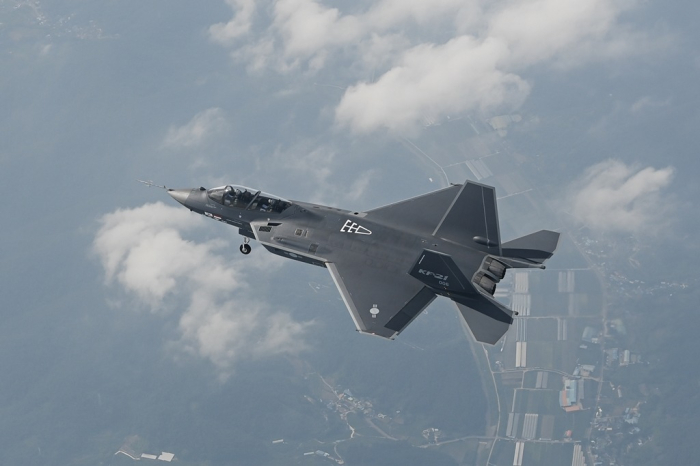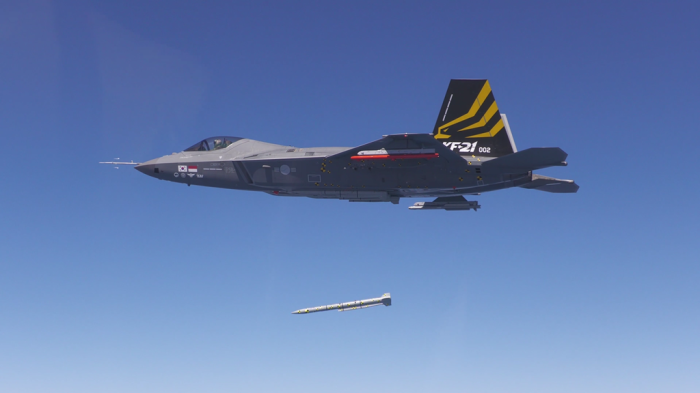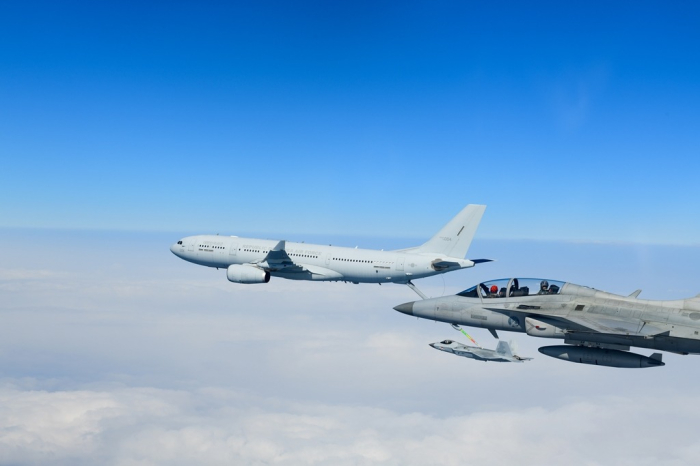Aerospace & Defense
KAI inks $1.4 bn supersonic fighter jet mass production deal
S.Korea plans to introduce 20 units of the KF-21 in stages from 2026 to replace the aging fleet of F-4, F-5 fighters
Jun 25, 2024 (Gmt+09:00)
2
Min read
Most Read
Macquarie eyes its 1st Korean data center valued around $722 mn


S.Korea's LS Materials set to boost earnings ahead of IPO process


SK Inc. in talks to sell PharmtecoŌĆÖs US CDMO plant to Novo Nordisk


Galaxy Ring, new foldables set to steal the show at Samsung Unpacked Paris


POSCO gears up for carbon-free steelmaking with hydrogen



Korea Aerospace Industries Ltd. (KAI), the countryŌĆÖs sole military aircraft manufacturer, said on Tuesday it signed a 2 trillion won ($1.4 billion) deal with the government to mass-produce the KF-21 to bolster the national air force while aiming to export the homegrown supersonic fighter jet.
KAI agreed with the Defense Acquisition Program Administration (DAPA), South KoreaŌĆÖs state-run arms procurement agency, to supply 20 units of the KF-21 from 2026 in stages, as well as technical manuals and training.
ŌĆ£The KF-21, a symbol of true self-defense, will contribute to improving the power of the national air force and further developing the advanced aerospace industry,ŌĆØ said KAI CEO Kang Goo-young in a statement issued on the 74th anniversary of the Korean War, which broke out on June 25, 1950.
The supersonic jet is set to replace the South Korean Air ForceŌĆÖs F-4 Phantom II fighter-bombers, which were recently retired, and the aging F-5 supersonic fighter jets, which are scheduled to end services.
KAI, which sold the KF-50 light fighter jets to Poland and Malaysia, aims to export the KF-21 taking advantage of the growing global interest in South Korean military aircraft.
ŌĆ£The KF-21 is highly regarded in the 4.5 generation fighter jet market as it is the first fighter jet with state-of-the-art avionics, advanced materials and technology developed since the emergence of the Fourth Industrial Revolution, which is technology such as AI and big data,ŌĆØ KAI said, referring to artificial intelligence.

DECADE FOR DEVELOPMENT
South Korea launched the project to develop a next-generation supersonic fighter jet with Indonesia in 2015 using the Northeast Asian countryŌĆÖs homegrown technology for key components to replace its aging fleet of F-4 and F-5 fighters, third-generation US-designed jets introduced in the 1960s.
Seoul continued to develop the supersonic fighter jet although Indonesia did not pay its share of the project's cost. South Korea accepted the partnerŌĆÖs request to cut its share of payments to one-third of the originally agreed amount.
The development rate of the KF-21 is at 80%, but it has proven its performance and stability through initial test flights.
The warplane, nicknamed Boramae, succeeded in air-to-air refueling in March and completed the test of firing the Meteor, a European active radar-guided, beyond-visual-range air-to-air missile. The KF-21 is increasing the completeness of a fighter jet by ramping up aircraft altitude, speed and maneuverability for wider operational areas.

South Korea gave the initial nod in March for mass production of the KF-21, which had won provisional approval as a jet suitable for combat in May 2023.
KAI has been preparing for the fighter jetŌĆÖs mass production since earlier this year by checking the supply chain with contractors, setting up production equipment and securing jigs and fixtures.
The company aims to procure 65% of the parts for the KF-21 in South Korea by working with about 600 local companies.
By Hyung-Kyu Kim
khk@hankyug.com
┬Ā
Jongwoo Cheon edited this article.
More to Read
-
 Aerospace & DefenseS.Korea to mass-produce homegrown fighter jet in 2024
Aerospace & DefenseS.Korea to mass-produce homegrown fighter jet in 2024Jan 10, 2024 (Gmt+09:00)
1 Min read -
 Aerospace & DefenseSouth Korea to accept IndonesiaŌĆÖs KF-21 project cost cut proposal
Aerospace & DefenseSouth Korea to accept IndonesiaŌĆÖs KF-21 project cost cut proposalMay 08, 2024 (Gmt+09:00)
3 Min read -
 Aerospace & DefenseKAI completes 1st batch of fighter jet exports to Poland
Aerospace & DefenseKAI completes 1st batch of fighter jet exports to PolandJan 02, 2024 (Gmt+09:00)
2 Min read -
 Aerospace & DefenseS.Korea mulls plan B as Indonesia falls behind on KF-21 project payments
Aerospace & DefenseS.Korea mulls plan B as Indonesia falls behind on KF-21 project paymentsNov 01, 2023 (Gmt+09:00)
4 Min read -
 Aerospace & DefenseKAI secures deal to export 18 FA-50 light fighters to Malaysia
Aerospace & DefenseKAI secures deal to export 18 FA-50 light fighters to MalaysiaMay 23, 2023 (Gmt+09:00)
1 Min read
Comment 0
LOG IN


